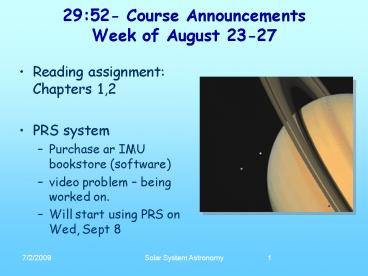Solar System Astronomy PowerPoint PPT Presentation
1 / 18
Title: Solar System Astronomy
1
2952- Course AnnouncementsWeek of August 23-27
- Reading assignment Chapters 1,2
- PRS system
- Purchase ar IMU bookstore (software)
- video problem being worked on.
- Will start using PRS on Wed, Sept 8
2
Lecture learning Goals
- Celestial sphere (definition and usage)
- Daily motion of stars and solar system bodies in
sky - Definitions of zenith, horizon, ecliptic, zodiac
- Constellations
- Cause of the seasons
- Vernal, autumnal equinox
- Summer, winter solstice
- Precession Motion of North celestial pole
3
Coordinates in the sky Horizon System
Zenith point directly overhead at any
time Horizon the lowest point you can see (the
ground)
4
Celestial Sphere Extension of the Earths
Coordinate System
- celestial sphere
- N/S celestial poles
- celestial equator
Like a salad bowl over your head!
5
Apparent westward motion of sky
Due to Earths rotation about its axis every
24h in an EASTWARD direction To us, it appears
as if objects in the sky are moving
WESTWARD Sun rises in the E, Sun sets in W
6
The Night Sky at the North Pole Polaris (N.
Celestial Pole) fixed overhead
Time-lapse picture from the North Pole looking
straight up (zenith)
7
The Night Sky at the Equator North South
Celestial Poles are on the horizon
North Celestial Pole (North Star)
8
Most of us are in between these extremes we see
fixed Polaris (N. Celestial Pole star) over the
night, stars move WESTWARD about it
Looking North
E
W
9
Transit Crossing the observers prime meridian
- All celestial bodies rise in the east, set in the
west - A line running from N to S crossing the zenith is
the prime meridian - Objects transit when crossing this imaginary line
- Transiting objects are always due south and are
highest in the sky (highest elevation)
Prime meridian line
Transit
10
Prime Meridian
11
Earths rotation and the apparent motion of stars
- All celestial bodies (stars, planets, sun, moon)
appear to move across the sky east to west - This is caused by the Earth rotating (west to
east) on its own axis, like a spinning top. - The Earths rotational period is 23h 56m 4s. (NOT
24h!) This is called the sidereal period. - Hence, all stars are at the same position in the
sky every successive sidereal period. - This implies that all stars rise appx. 4 minutes
earlier each night. - Since 4 min x 365 days 24 hr, the night sky
patterns repeat annually for a given time of
night
12
Daily Motion of Stars, Solar system objects on
the Sky
- Stars move along the same westward track every
night (ignores precession, discussed later in
lecture) - Stars rise, transit, and set 4 min earlier every
night. - Solar system objects also move east to west each
night, but their tracks are more complicated
(because apparent motion is affected by Earths
orbital motion around Sun) - The Sun and all planets (except Pluto) move along
the line of the ecliptic plane, described in next
slide. - Planets generally move eastward with respect to
the stellar background, except during retrograde
motion (Chap 3) - The Moons motion is the most complicated we
will discuss this in chapter 2.
13
Night sky The Movie Iowa City this evening (Aug
25) looking south
West
East
14
Night sky at 24 hour intervals (Solar period)
15
Night sky at 23h 56m 4s intervals (Sidereal
period)
16
Motion of the Sun Solar vs. Sidereal period
- Since the Earth moves in its orbit each day, the
motion of (nearby) solar system objects is
slightly different from stars. - The Earth needs to rotate an additional 1 degree
daily for the Sun to repeat its position (see
diagram at right). - This takes an additional 4 min
- This means that the Suns position repeats every
24 hrs. This is called the solar period.
17
Analemma Solar Position at Noon throughout year
Sun does not transit prime meridian at 1200 noon!
Expected position at along prime meridian at noon
(mean Sun)
18
Why the Analemma? Because the Earth orbit around
the Sun is not perfectly circular Equation of
Time
- This effect is caused by
- Obliquity ( tilt of Earths axis)
- Ellipticity of Earths orbit (Earth moves more
slowly when farther away from Sun)
Maximum difference from uniform motion (Sun
transits at noon daily) is 16 min

